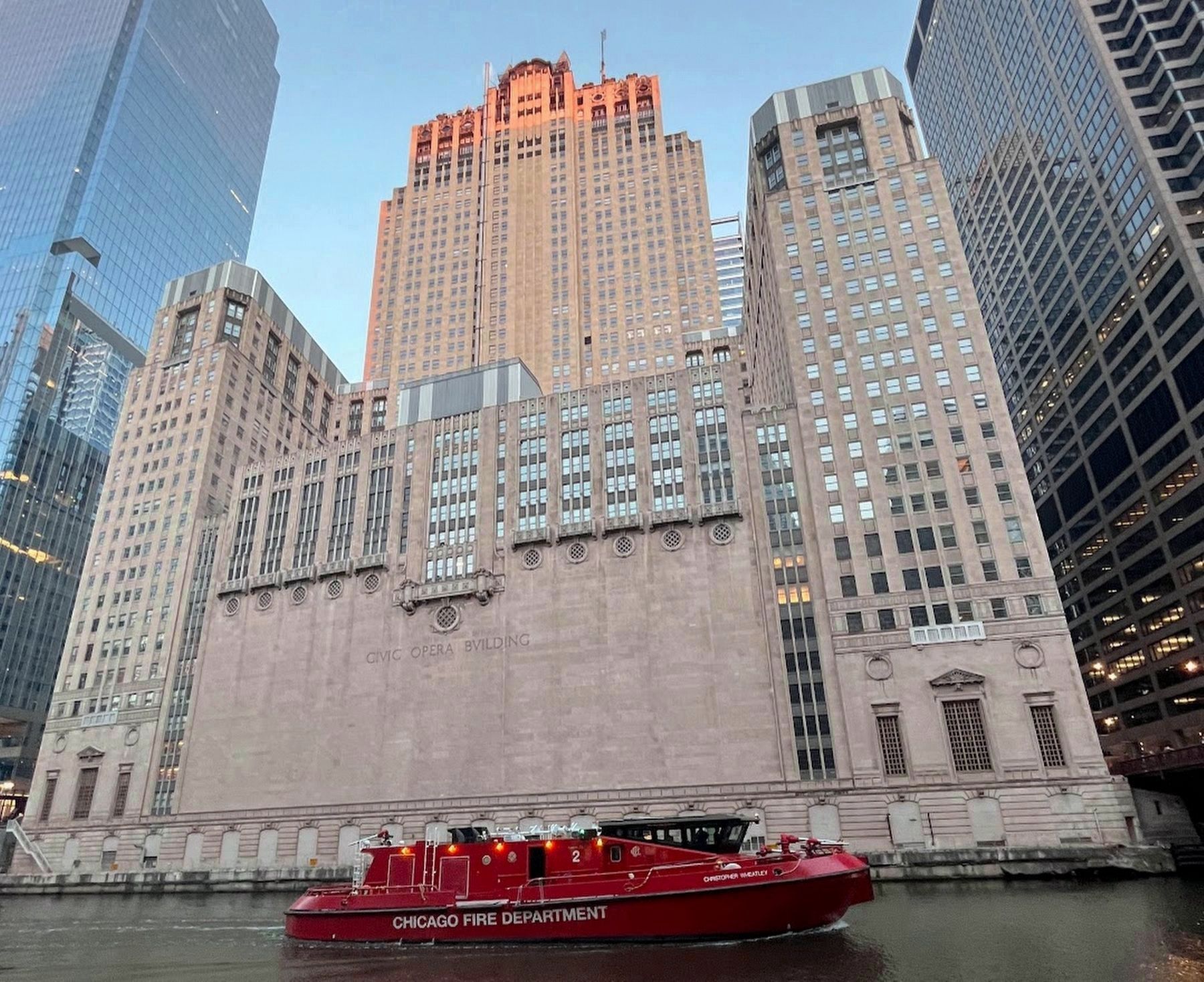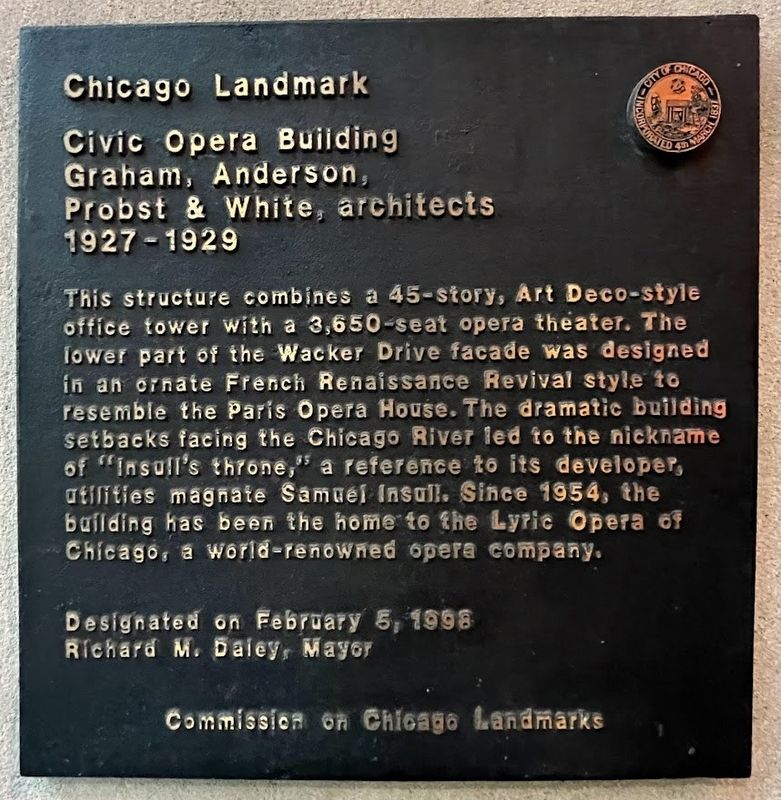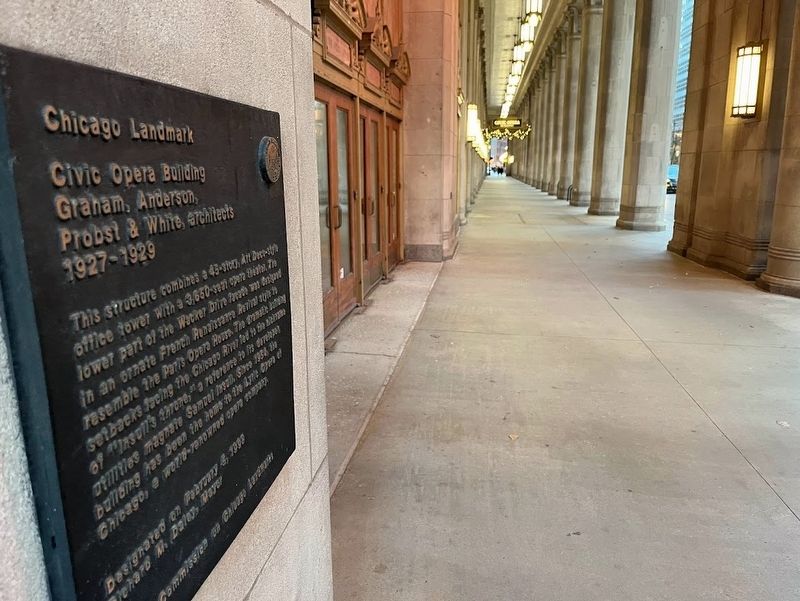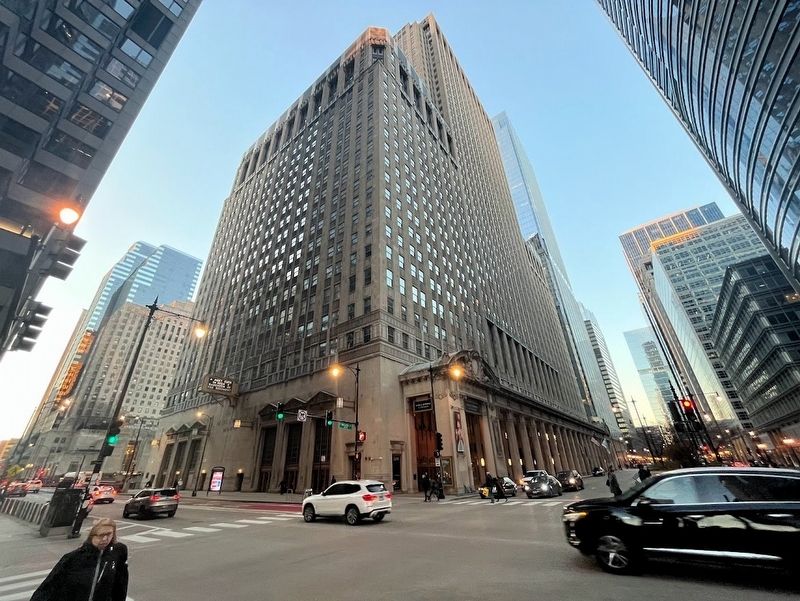The Loop District in Chicago in Cook County, Illinois — The American Midwest (Great Lakes)
Civic Opera Building
Graham, Anderson, Probst & White, architects; 1927-1929
— Chicago Landmark —
This structure combines a 45 story, Art Deco-style office tower with a 3,650-seat opera theater. The lower part of the Wacker Drive facade was designed in an ornate French Renaissance Revival style to resemble the Paris Opera House. The dramatic building setbacks facing the Chicago River led to the nickname of "Insull's throne," a reference to its developer, utilities magnate Samuel Insull. Since 1954, the building has been the home to the Lyric Opera of Chicago, a world-renowned opera company.
Designated on February 5, 1998
Richard M. Daley, Mayor
Erected 1998 by Commission on Chicago Landmarks; City of Chicago.
Topics and series. This historical marker is listed in these topic lists: Architecture • Arts, Letters, Music • Entertainment. In addition, it is included in the Art Deco series list. A significant historical year for this entry is 1927.
Location. 41° 52.924′ N, 87° 38.231′ W. Marker is in Chicago, Illinois, in Cook County. It is in The Loop District. Marker is at the intersection of North Wacker Drive and West Madison Street, on the right when traveling south on North Wacker Drive. The marker is at the southeast corner of the building, near the south entryway to the covered sidewalk. Touch for map. Marker is at or near this postal address: 360 W Madison St, Chicago IL 60606, United States of America. Touch for directions.
Other nearby markers. At least 8 other markers are within walking distance of this marker. Washington Block (approx. 0.2 miles away); 300 West Adams Street Office Building (approx. 0.2 miles away); Site of the Sauganash Hotel/Wigwam (approx. ¼ mile away); Lincoln's Nomination Site (approx. ¼ mile away); Sauganash Hotel - Chicago - 1831 (approx. ¼ mile away); First Post Office (approx. ¼ mile away); Wacker Drive (approx. ¼ mile away); Lake-Franklin Group (approx. ¼ mile away). Touch for a list and map of all markers in Chicago.
Regarding Civic Opera Building. Samuel Insull, a British-born businessman and key figure in the utilities, railroad and broadcasting industries and prominent charitable and arts-related benefactor, was a major patron of the Chicago Civic Opera and commissioned this building in 1926. It opened in 1929, the same year as the Wall Street Crash, which would lead the demise of Insull's holding company and, in turn, a complete loss for its shareholders. Insull fled to Europe but was eventually extradited to the United States and charged with antitrust and mail fraud, for which a jury found him not guilty. He died in 1938 in Paris and is buried in London.
Orson Welles cited Insull as an inspiration for "Citizen Kane," based on the legend that Insull built the Civic Opera House for his wife Gladys Wallis, an actress. Welles denied that Gladys was the basis for the movie's Susan Alexander character, but elements of the Insulls' life did appear in the script, and he used a photo of Insull to develop the look of late-life Charles Foster Kane. Another Chicagoan, Harold Folwer McCormick, the son of inventor Cyrus Hall McCormick and chairman of the board of the International Harvester Company, was cited by Welles as another inspiration; McCormick's second wife Ganna Walska was an opera singer that many contemporaries believed to have a terrible voice.
Also see . . .
1. Chicagology: Civic Opera House. This page features historic articles and photos of the Civic Opera Building. (Submitted on November 19, 2023, by Sean Flynn of Oak Park, Illinois.)
2. Lyric Opera House History.
From the Lyric Opera of Chicago: "Opened as the Civic Opera House in 1929, the building was the vision of utility magnate Samuel Insull (1859–1938), a populist billionaire known as 'the Prince of Electricity.' Insull, the president of the Chicago Civic Opera Association, wanted to erect a new opera house to replace Louis B. Sullivan's Auditorium Building on South Michigan Avenue as the home of the Chicago Civic Opera — one that would be democratic in scope, and would be housed in and supported by a commercial office building. He mandated five requisites for the new opera house: safety, excellent sight lines, comfortable seating, gracious surroundings, premium acoustics."(Submitted on November 19, 2023, by Sean Flynn of Oak Park, Illinois.)
Additional keywords. chicago lyric opera

Photographed By Sean Flynn, November 18, 2023
4. Civic Opera Building, view from the Chicago River
The building is sometimes known as Insull's Throne, a reference to the man who commissioned it, utilities magnate Samuel Insull, and a design that looks a lot like a chair overlooking the Chicago River. In the foreground is the Christopher Wheatley, Chicago's fire boat, which was passing the opera house when this photo was taken from the water taxi stop across the river. The boat has four water cannons, operates all year long and can break ice on the river if needed. It is named after a Chicago firefighter who died in the line of duty in 2010 at a restaurant about a third of a mile west of this location.
Credits. This page was last revised on November 19, 2023. It was originally submitted on November 19, 2023, by Sean Flynn of Oak Park, Illinois. This page has been viewed 62 times since then and 27 times this year. Photos: 1, 2, 3, 4. submitted on November 19, 2023, by Sean Flynn of Oak Park, Illinois. • Devry Becker Jones was the editor who published this page.


